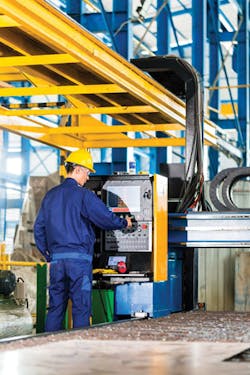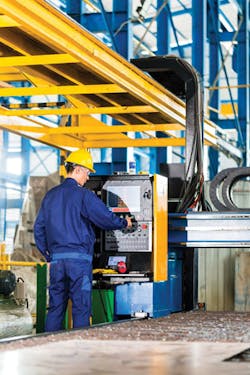Industrial cabling standards to address higher speeds, fewer wires, and longer distances
By Patrick McLaughlin
The Telecommunications Industry Association’s (TIA) standard-development committee TR-42 Telecommunications Cabling Systems Engineering Committee includes several subcommittees, one of which is TR-42.9, Industrial Telecommunications Infrastructure. That subcommittee originally produced and has revised the ANSI/TIA-1005 Telecommunications Infrastructure Standard for Industrial Premises. Most recently, the standard was revised to its “A” version, ANSI/TIA-1005-A, in 2012.
Since the time of that revision, the TR-42.9 subcommittee began working on addenda to the standard and on other specifications, to address the evolving industrial, manufacturing, and other challenging environments that require network connectivity.
Robert Lounsbury, principal engineer with Rockwell Automation (www.rockwellautomation.com), recently was elected chair of TIA TR-42.9. In an interview with Cabling Installation & Maintenance he explained, “There are three active projects in TR-42.9 that will have a direct impact on TIA-1005-A.” One project deals with data transmission over a single wire pair (versus the two- or four-pair schemes most often deployed in networks). Another project will specify the cabling required for four-pair, 100-meter gigabit-speed transmission in noisy industrial environments. And a third project will redefine cabling channels by adding the two end connections to the limits.
1 Gig over 1 pair
Specifications for a single-pair cabling system that will support speeds of 1 Gbit/sec for distances up to 40 meters will be included in an addendum to ANSI/TIA-1005-A. TR-42.9 is developing the addendum in parallel with the Institute of Electrical and Electronics Engineers’ (IEEE; www.ieee.org) 802.3bp 1000Base-T1 PHY Task Force. The 802.3bp project’s objectives were updated most recently in July 2014. Among the objectives are, “Support 1 Gbit/sec operation in automotive and industrial environments (e.g. EMC [electromagnetic compatibility], temperature),” and, “Define the performance characteristics of optional link segment(s) … for industrial controls and/or automation, transportation (aircraft, railway, bus and heavy trucks) applications with a goal of at least 40-meter reach.”
The current project within TR-42.9 is, essentially, to specify cabling that is capable of supporting the above-quoted objectives. Although the cable technology has not yet developed to a point at which prototypes have been brought forth, Lounsbury said a one-pair cable that will support gigabit speeds to at least 40 meters is likely to be a shielded cable with low loss. “Although probably not much less expensive than a four-pair gigabit-capable cable-there are economies of scale at work when manufacturers produce four-pair cable that will not apply to a one-pair cable-the one-pair cable will be easier to terminate and will take up less space in ductways,” he pointed out.
Additionally, Lounsbury noted, the electronic devices to which one-pair cabling will connect, will be simplified. Speaking from the perspective of a company that produces such electronic devices and interfaces, Rockwell Automation’s Lounsbury observed, “We are constantly being driven, by our customers, to produce more-powerful, smaller products.” Science that bears itself out in all kinds of networked equipment holds true here too; creating more-powerful circuits in more-compact space results in increased heat as well as power dissipation in those spaces. A single-pair rather than four-pair connection is advantageous. “If we move from the RJ45 to a robust, sealed single-pair connector, it helps to shrink the product,” Lounsbury explained. “Additionally, the components inside the electronics, between the connector and the PHY, are smaller.” The existence of less circuitry there helps in both enabling a more-compact design and in lowering the heat generation and power dissipation within the devices.
When 802.3bp was in its initial stages of gaining project approval, the task force’s chair, Steve Carlson, contributed a post to the Ethernet Alliance Blog (www.ethernetalliance.org/blog) titled “Single Twisted Pair: The Next Frontier.” In the post, Carlson explained, “Not all networks need to operate at the fastest possible speed. Speed is related to the needs of the application, and many applications are well served by what would be considered low-speed links. The IEEE P802.3bp 1000Base-T1 PHY Task Force is developing a standard for full-duplex operation at 1-Gbit/sec over a single twisted copper wire pair …”
Later in the post he projects, “It’s likely that the 1000Base-T1 PHY will find homes in a wide variety of m2M (machine-to-machine) and ‘Internet of Things’ devices, especially when combined with IEEE 802.3bu Power over Data Lines Task Force that will deliver DC power over the same twisted wire pair.”
Yes, it will be possible to send both gigabit-speed data and power over a single twisted pair when the IEEE’s 802.3bp and 802.3bu specifications are completed. In our interview, Rockwell Automation’s Lounsbury further explained, “The amount of power available has not yet been determined, but power and high-speed data will be delivered to a freestanding device.” Just as the IEEE 802.3af and at specifications have made powering certain network devices cost-effective and efficient, developers of the 802.3bp and 802.3bu specifications anticipate similar benefits and efficiencies when these two specifications are applied in industrial settings. It will eliminate the need to run power buses to all network devices in these environments.
In keeping with Carlson’s comment about not all networks needing to operate at the fast possible speed, another possible application of IEEE 802.3bp specifications would focus on 10-Mbit/sec speeds. In a meeting scheduled to take place the week of November 9, the group expected to receive a proposal to add a study group that would focus on transmitting data at 10 Mbits/sec over a single twisted pair to a length of 1 kilometer. If it moves forward, the resulting set of specifications will have a home in process manufacturing industries-including food-and-beverage, chemical, pharmaceutical, and packaged-goods industries-where the manufacturing environment typically includes long distances between pieces of machinery.
A vision of speed requirements
Also within TIA TR-42.9, work continues on a specification for cabling to support 1-Gigabit data transmission speed over four-pair cabling in environments with elevated noise levels. While 10- and 100-Mbit/sec transmission speeds are sufficient for many industrial communication and control systems, some are constrained by a 100-Mbit/sec maximum speed.
In some cases, an industrial control system’s maximum speed of 100 Mbits/sec may prohibit the company from manufacturing product with greater speed, so a tenfold speed increase will enable more productivity. In many cases, the use of vision systems in the production environment is driving the need for higher-speed systems. Motion is an essential element of a vision system, and as Lounsbury points out, “Motion is very demanding. Even though the packets are small, the number of packets that must be transmitted in a short period of time is significant.”
ODVA (www.odva.org) promulgated the 1-Gigabit, 4-pair standardization effort within TR-42.9. ODVA is a 20-year-old organization that describes its membership as “the world’s leading automation companies.” The association further says its mission is “to advance open, interoperable information and communication technologies in industrial automation. ODVA recognizes its media-independent network protocol, the Common Industrial Protocol or ‘CIP’, and the network adaptations of CIP-EtherNet/IP, DeviceNet, CompoNet and ControlNet-as its core technology and the primary common interest of its membership.”
Historically devices incorporating ODVA’s EtherNet/IP technology maxed out at 100 Mbits/sec, and gigabit speeds came into play “for large-scale, enterprise-connected and enterprise-integrated systems,” (source: “Network Infrastructure for EtherNet/IP: Introduction and Considerations,” published by ODVA). Gigabit-speed connections have been used “for switch-to-switch uplink or backbone connections, not control connections to EtherNet/IP devices. EtherNet/IP industrial control devices support 10-Mbit/sec and 100-Mbit/sec data rates. The decentralized architecture of industrial Ethernet reduces the need for large concentrations of devices and higher-than-100-Mbit/sec connections.”
That has been true historically, but as mentioned earlier, the implementation of vision systems in industrial environments is forcing that data rate up to gigabit speeds. With the need for gigabit-speed connectivity to industrial devices emerging, TIA TR-42.9 is setting about a task to what it began to undertake approximately 15 years ago: Evaluate the use of Ethernet cabling in industrial space (this time for gigabit speeds), including both the physical and performance characteristics of that cabling.
Lounsbury recalls that during the creation of the original TIA-1005 standard, the group found that the twisted-pair cabling used to support 10- and 100-Mbit/sec data transmission in a commercial office building environment would not necessarily have the physical or performance characteristics necessary to support those same speeds in noisy, unforgiving industrial environments. Today, as TR-42.9 defines specifications for gig-capable twisted-pair cabling in equally unforgiving environments, it is finding that performance enhancements will be necessary. Lounsbury noted that increasing data transmission rate from 100 to 1000 Mbits/sec tightens a cabling system’s allowable noise margin by 6 dB. Whereas TIA standards are used primarily in North America, Lounsbury pointed out, “We like to make sure we support both UTP and screened cables in industrial environments,” adding, “We see some changes coming for UTP cable in order to support gigabit speeds in industrial environments.”
TR-42.9’s work on four-pair, gigabit-speed industrial cabling is ongoing.
End-to-end link
A third effort within TR-42.9 seeks to define what is being called end-to-end link; the effort corresponds to work being carried out within the International Electrotechnical Commission (IEC) SC 25 (Interconnection of Information Technology Equipment) Working Group 3 (Customer Premises Cabling).
That group’s work ultimately will be published as ISO/IEC 11801-99-02; the term “end-to-end link” is often abbreviated “E2E link.” Oversimplifying the effort from a technical standpoint, the E2E link initiative will include the plugs at each end of a channel. Channels as defined in TIA-568 and ISO/IEC 11801 specifications exclude the plugs at the ends of the channel’s equipment and work-area cords. Including rather than excluding these plugs “creates the need for new models and new limit lines,” Lounsbury said.
Defining those limits is a technical challenge for the standards-making groups involved, including IEC SC 25 WG 3 as well as TIA TR-42.9, and they continue to work toward their objectives. Early in 2015, in an edition of its Standards Advisor, CommScope (www.commscope.com) provided the following update on the process and the draft document: “The scope was clarified to only include E2E links and any reference to channels were removed. The document is for Class D and E links with up to 5 link segments and up to 6 connections including the connections at both ends. Class EA will be included in an informative annex since alien crosstalk specifications are not currently included.”
CommScope’s reference to as many as 6 connections and 5 segments in an industrial cabling circuit sheds light on the fact that these cabling runs often include more segments and connections than typically found in other network environments, such as commercial office buildings or data centers. As such, the possibility exists for any of these connection points to introduce excessive loss and adversely affect data transmission. The specifications being developed within ISO/IEC and within TIA TR-42 related to end-to-end link are intended to ensure that cabling channels in manufacturing and industrial environments do indeed support their intended applications.
While other standards developed within TR-42 get more headlines and press (including in this magazine and its website), the work being carried out by the TR-42.9 Industrial Telecommunications Infrastructure subcommittee has a significant impact on the operations and connectivity within manufacturing and industrial environments. The efforts TR-42.9 is currently undertaking promise to support and enhance business in these environments.
Patrick McLaughlin is our chief editor.

